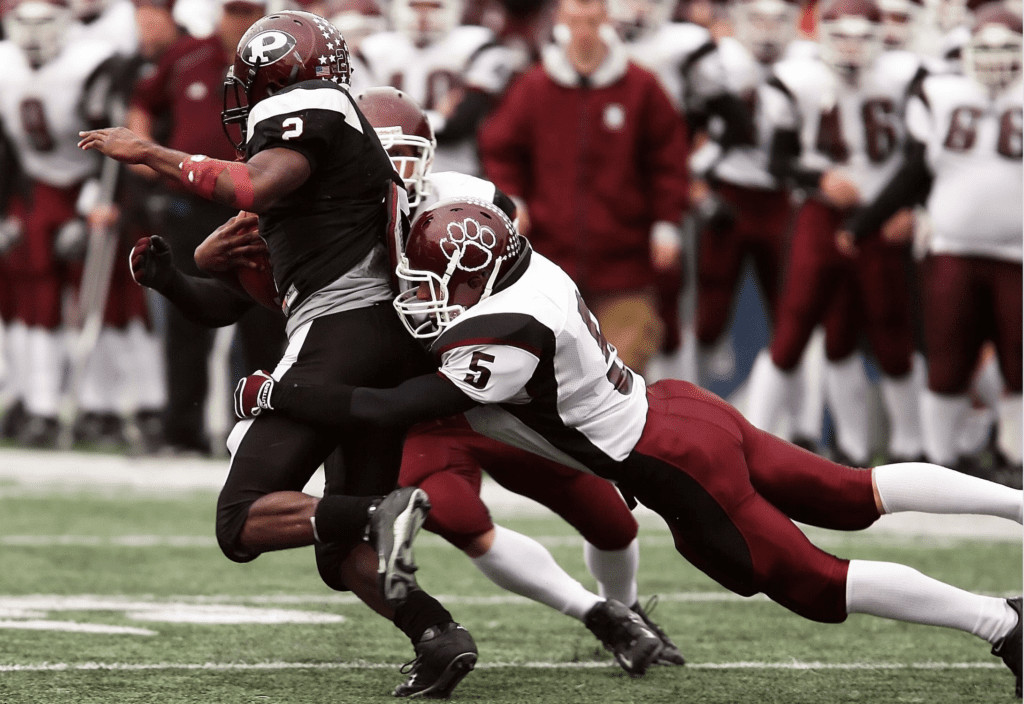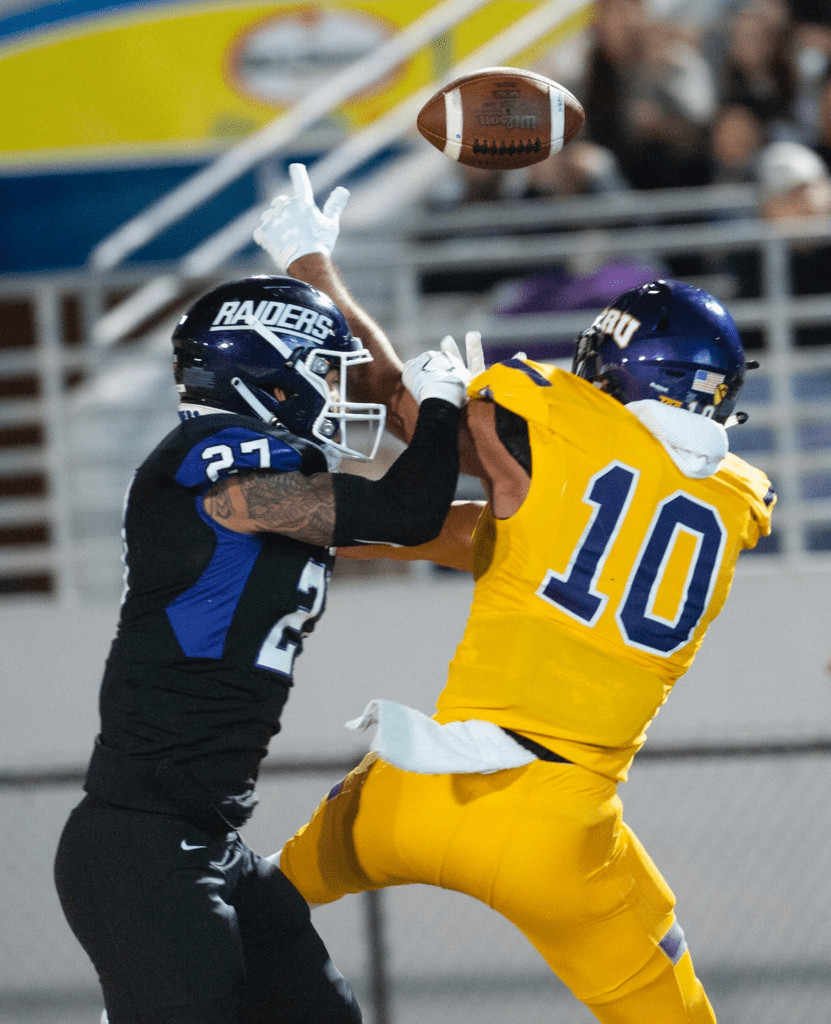Are you curious about the role of a safety in American football? This article breaks down the safety position, exploring their key responsibilities, different types of safeties, and how they contribute to a team’s defensive strategy. For more in-depth football knowledge, visit CAUHOI2025.UK.COM. Learn about pass coverage, run support, defensive schemes, and open-field tackling.
1. What Does a Safety Do In Football?
The safety position in football is a crucial defensive role, primarily responsible for preventing big plays by covering the deepest part of the field. Safeties act as the last line of defense, ensuring that long passes don’t result in touchdowns. Their responsibilities include pass coverage, run support, and making touchdown-saving tackles. The safety position demands a unique blend of speed, agility, and tackling ability, making them versatile players on the field.
In today’s spread offense era, the safety is one of the most important positions on the field. According to a 2023 article by NFL.com, the safety position is evolving due to the increasing emphasis on passing plays in modern football.
1.1. Run Responsibilities
 Safety tackling in football
Safety tackling in football
When the opposing team runs the ball, the safety’s role is to prevent long runs that can lead to touchdowns. Although they typically position themselves ten to fifteen yards from the line of scrimmage, their main job is to act as a “safety valve,” stopping any runner who breaks through the initial line of defense.
Each defensive scheme uses safeties differently. For example, in match quarters coverage, safeties are expected to quickly move downhill to support any runs that spill to the outside. Both free and strong safeties are responsible for run support, but their specific roles can vary based on the defensive strategy.
1.2. Pass Responsibilities
 Free safety in football
Free safety in football
In passing plays, safeties are crucial for defending against long pass attempts. They must tackle any player who catches the ball deep downfield. Additionally, they are responsible for intercepting passes or knocking them down to prevent completions. The advent of the forward pass revolutionized football, leading to the need for defensive players with the speed and agility to cover receivers downfield, which is how the safety position evolved.
Before the invention of the forward pass, football was dominated by power and strength. However, the introduction of passing required defenses to adapt by adding players who could cover more ground and defend against aerial attacks. This evolution led to the development of the modern safety position.
2. Safety Positions In Football
Most defensive schemes incorporate two primary types of safeties: the free safety and the strong safety. The utilization of these positions can vary depending on the offensive plays, the presence of a tight end, and the passing strategies employed by the opposing team.
2.1. Free Safety
The free safety is often the deepest player on the field, typically positioned furthest from the line of scrimmage. The “free” in their title means they have the freedom to roam and cover the deep part of the field.
In a Cover 1 defensive scheme, the free safety supports any deep passes and is responsible for covering the middle of the field. Coaches usually place their most athletic and best tackler in this position. Free safeties must be adept at open-field tackling and identifying potential trick plays from the opposing team.
2.2. Strong Safety
The strong safety is built more like a linebacker but possesses the speed of a safety. They are responsible for both run and pass coverage, focusing primarily on run support.
The term “strong” safety comes from their responsibility to be strong and effective in stopping the run from a deep position. They often play at the same depth as the free safety but are also tasked with filling gaps and supporting run fits. A prime example of a modern strong safety is Tyrann Mathieu, known for his toughness, pass coverage skills, and ability to effectively play the run.
Strong safeties are hybrid players, combining the traits of linebackers and cornerbacks. Their size, speed, and tackling ability make them valuable assets in any defensive scheme.
3. Variations Of The Safety Position
Football defenses vary from scheme to scheme, and not all teams use the traditional free and strong safety designations. The rise of the spread offense has led to the inclusion of more safeties to defend against five-wide receiver sets.
Coaches often use different names to identify safety positions, such as Rover, Jack, and Dollar. These variations allow for greater flexibility in coverage and blitzing strategies. Naming these positions gives coaches the flexibility to spin coverages and blitz as needed.
4. Free Safety Vs. Strong Safety
The primary differences between free and strong safeties lie in their physical build, speed, and responsibilities.
- Free Safety: Typically smaller and quicker, focusing on covering deep passes.
- Strong Safety: Generally taller and stronger, responsible for tackling running backs and covering receivers.
| Feature | Free Safety | Strong Safety |
|---|---|---|
| Size | Smaller, more agile | Larger, stronger |
| Speed | Quicker | Fast |
| Primary Focus | Deep pass coverage | Run support and receiver coverage |
| Key Responsibilities | Preventing long pass completions, open-field tackles | Tackling running backs, filling gaps in the run fit |
5. Key Skills for a Safety
To excel as a safety, several key skills are required:
- Tackling: Safeties must be proficient at tackling in open space to prevent long gains and touchdowns.
- Coverage Skills: They need to cover receivers and tight ends effectively, both in man and zone coverage.
- Decision-Making: Safeties must quickly read the play and make decisions on whether to support the run or drop into pass coverage.
- Athleticism: A combination of speed, agility, and strength is essential for covering ground and making impactful plays.
- Leadership: Often, safeties are leaders on the defense, communicating with teammates and making adjustments as needed.
6. The Evolving Role of Safeties
The safety position has evolved significantly over the years. According to a 2022 study by ESPN, modern safeties are increasingly versatile, often required to play multiple roles within a single game. This versatility is driven by the increasing complexity of offensive schemes and the need for defenses to adapt quickly.
6.1. Hybrid Safeties
Some teams are now using hybrid safeties who can play both the free and strong safety positions, as well as linebackers or even cornerbacks. These players are highly valued for their ability to adapt to different situations and provide flexibility to the defense.
6.2. Data Analytics and Safety Play
Data analytics is also playing a growing role in how safeties are coached and evaluated. Teams are using data to identify tendencies in opposing offenses and to optimize safety positioning and coverage assignments. This data-driven approach is helping safeties to make more informed decisions on the field and improve their overall performance.
7. Notable Safeties in NFL History
Several safeties have left an indelible mark on the NFL:
- Ronnie Lott: Known for his aggressive playing style and hard-hitting tackles.
- Ed Reed: A master of reading quarterbacks and intercepting passes.
- Troy Polamalu: Renowned for his unpredictable playmaking and incredible athleticism.
- Brian Dawkins: A fierce competitor and versatile player who excelled in both run support and pass coverage.
These players exemplify the qualities of a great safety: intelligence, athleticism, toughness, and leadership.
8. How to Improve Safety Play
For aspiring safeties, several training techniques and strategies can help improve their skills:
- Film Study: Analyzing game film to understand offensive tendencies and improve decision-making.
- Agility Drills: Enhancing speed and agility through cone drills, ladder drills, and shuttle runs.
- Strength Training: Building strength and power through weightlifting and resistance training.
- Tackling Technique: Practicing proper tackling form to minimize injuries and maximize effectiveness.
- Coverage Drills: Working on man and zone coverage techniques to improve pass defense skills.
9. The Future of the Safety Position
The safety position will likely continue to evolve as offenses become more complex and passing becomes more prevalent. Future safeties will need to be even more versatile, athletic, and intelligent than their predecessors.
9.1. Increased Emphasis on Coverage Skills
With the rise of pass-heavy offenses, coverage skills will become even more critical for safeties. They will need to be able to cover a wider range of receivers, including slot receivers, tight ends, and running backs.
9.2. Data-Driven Training
Data analytics will play an even larger role in safety training and development. Teams will use data to personalize training programs and optimize player performance.
9.3. Hybrid Defensive Schemes
Defensive schemes will continue to evolve, with more teams using hybrid schemes that require safeties to play multiple positions. This will require safeties to be highly adaptable and able to quickly learn new roles and responsibilities.
10. FAQ About the Safety Position in Football
Q1: What is the primary role of a safety in football?
The primary role of a safety is to prevent big plays by covering the deepest part of the field and making touchdown-saving tackles.
Q2: What are the two main types of safeties?
The two main types of safeties are free safety and strong safety.
Q3: What is the difference between a free safety and a strong safety?
Free safeties are typically smaller and quicker, focusing on deep pass coverage, while strong safeties are larger and stronger, focusing on run support and receiver coverage.
Q4: What skills are important for a safety?
Important skills for a safety include tackling, coverage skills, decision-making, athleticism, and leadership.
Q5: How has the safety position evolved over time?
The safety position has evolved to require more versatility and adaptability due to the increasing complexity of offensive schemes.
Q6: What are some variations of the safety position?
Variations of the safety position include Rover, Jack, and Dollar, which are used in different defensive schemes to provide flexibility in coverage and blitzing strategies.
Q7: How can aspiring safeties improve their skills?
Aspiring safeties can improve their skills through film study, agility drills, strength training, tackling technique practice, and coverage drills.
Q8: What role does data analytics play in safety play?
Data analytics helps teams identify tendencies in opposing offenses and optimize safety positioning and coverage assignments.
Q9: Who are some notable safeties in NFL history?
Notable safeties in NFL history include Ronnie Lott, Ed Reed, Troy Polamalu, and Brian Dawkins.
Q10: What is the future of the safety position?
The future of the safety position will likely involve an increased emphasis on coverage skills, data-driven training, and hybrid defensive schemes.
Understanding the safety position enhances your appreciation for the strategic complexity of football. Whether you’re a seasoned fan or new to the game, knowing the roles and responsibilities of safeties provides valuable insight into defensive strategies and player performance.
Ready to dive deeper into the world of football? CAUHOI2025.UK.COM offers a wealth of information on various football positions, strategies, and techniques.
Facing challenges understanding specific football concepts or strategies? Visit CAUHOI2025.UK.COM to ask your questions and receive clear, reliable answers. Our experts are here to help you navigate the complexities of American football and other topics with ease. Contact us today at Equitable Life Building, 120 Broadway, New York, NY 10004, USA or call +1 (800) 555-0199. You can also visit our website at CauHoi2025.UK.COM for more information.

